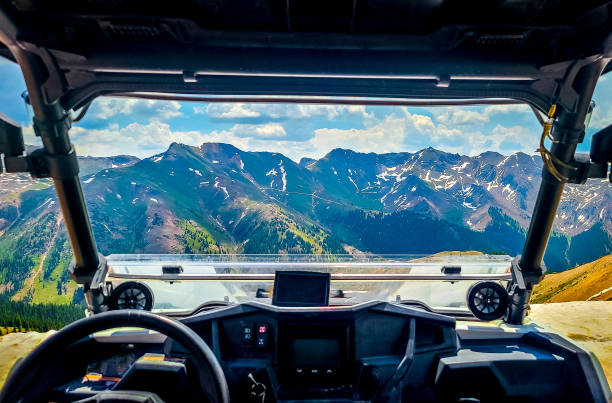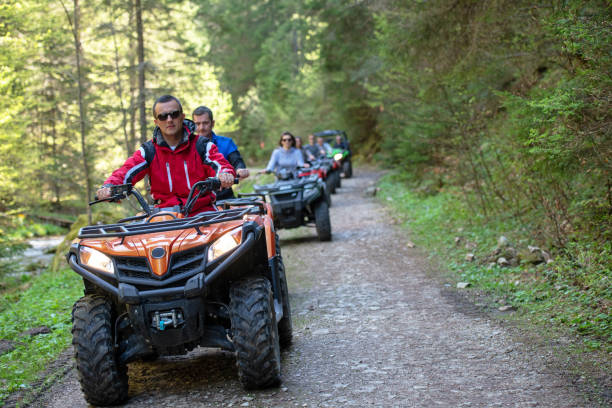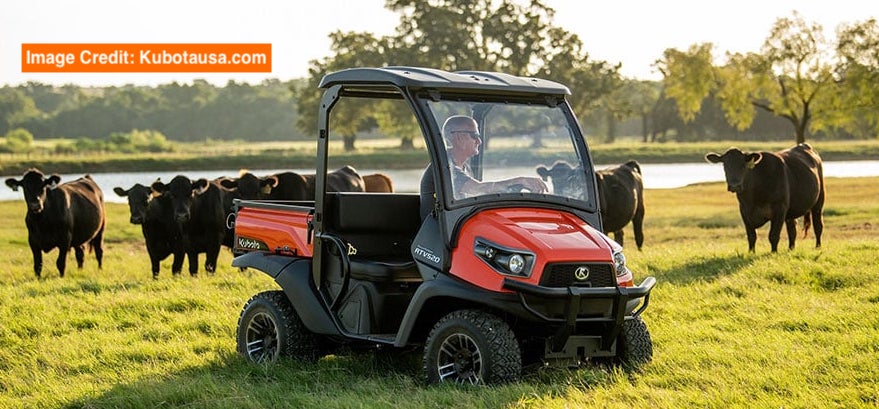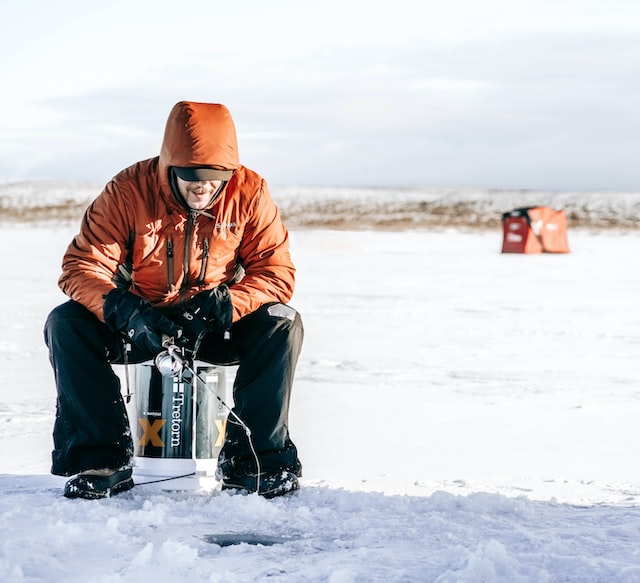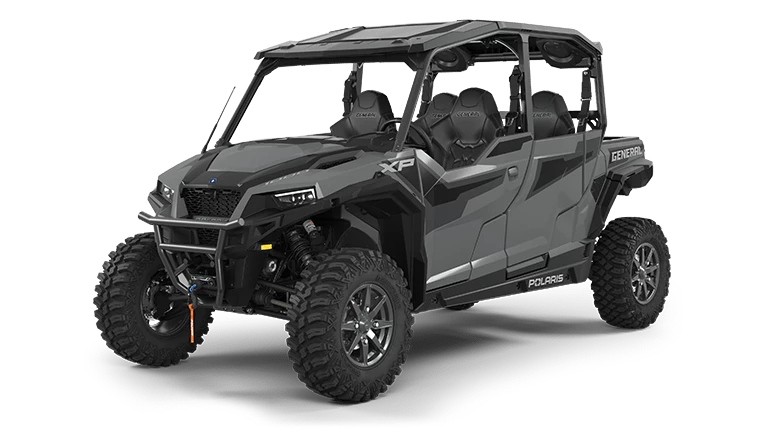As an Amazon Associate I may earn a commission from qualifying purchases at no additional cost to you.
Exploring the world of off-road vehicles presents many choices, but a common dilemma emerges when deciding between ATV hourly rates and Side by Side day pricing.
For those embarking on an adventure, comparing costs reveals important insights into what offers the most value for money.
Typically, ATVs may incur lower upfront costs on an hourly basis, while Side by Sides might provide better day-long value and offer a more comprehensive riding experience.

ATVs appeal to enthusiasts looking for a thrilling, solo escapade, often providing an exhilarating ride across rough terrains.
In contrast, Side by Sides, also known as UTVs, cater to those who prefer a group adventure, offering more space and comfort for longer excursions.
Understanding which option aligns with the planned activity and budget can make a significant difference in the off-road experience.
Whether it’s the solo adrenaline rush of an ATV or the shared journey of a Side by Side, deciding where to invest can be as adventurous as the ride itself.
Potential riders are encouraged to weigh their preferences and needs against the pricing and experience each vehicle offers.
Understanding ATVs and Side by Sides

Both ATVs and Side by Sides offer unique off-road experiences but differ in design and functionality. ATVs are compact and nimble, while Side by Sides provide more seating and storage.
Defining ATVs and Side by Sides
An All-Terrain Vehicle (ATV) is a small, open, and single-rider vehicle with handlebars. Often equipped with four wheels, ATVs are favored for their agility over rugged terrain. Popular models include the Yamaha Grizzly and Can-Am Outlander. They are well-suited for one rider, though some allow a passenger for short distances.
Side by Sides, also known as Utility Task Vehicles (UTVs), offer a different setup. These provide side-by-side seating for multiple passengers, steering wheels, and roll cages for safety. Models like the Polaris RZR and Honda Pioneer 500 cater to both recreational users and those needing utility on farms or ranches.
Key Features of ATVs
ATVs are heralded for their agility. Sport quads emphasize speed and performance, often used in racing scenarios.
Stability and traction are also key characteristics, essential for navigating slippery or uneven paths. While generally smaller in size, they can handle diverse terrains.
Traction is supported by specific tire types suited for different conditions. 4×4 capabilities enhance their ability to tackle difficult terrains.
Comfort may not be as pronounced compared to Side by Sides, though their seats and suspension still provide a reasonable ride quality.
Key Features of Side by Sides
Side by Sides emphasize comfort and versatility. The enclosed cabin can sometimes be weather-sealed, offering protection from the elements.
With higher seating capacity, they can accommodate more passengers and carry heavier loads, making them ideal for group outings.
Traction and stability are enhanced by wider tires and a more substantial build. These vehicles allow for easier driving, steering with a wheel instead of handlebars.
Known for their power, they manage rough terrain effectively while providing greater safety with advanced roll cages and seat belts.
Pricing Breakdown
In this section, we will explore the cost dynamics between ATV hourly rates and Side by Side day pricing. Each subsection breaks down critical pricing factors, including insurance and dealer options.
ATV Hourly Rates
ATV rentals typically vary based on the dealer and location. Prices range from $20 to $50 per hour.
This rate may or may not include insurance. It’s crucial to inquire at the dealership whether the cost covers potential damage or if separate coverage is necessary.
Factors like geographical location can affect rates significantly. For example, ATVs rented in popular tourist spots might cost more.
Some dealers offer discounts if renting for multiple hours, making longer adventures more cost-effective.
It is advisable to look for flexible payment options, which some dealers provide to incentivize customers.
Side by Side Day Pricing
Renting a Side by Side for a day generally has a higher MSRP but provides a full-day experience.
The out the door price can range from $150 to $400. This may include a variety of services, such as ground transport and basic insurance. Tax is often added to the base price and can vary by location.
Dealers sometimes offer promotional discounts, especially during off-peak seasons.
It’s possible to negotiate on the pricing if buying or renting from a dealership with available inventory. Also, flexible payment options may be provided in some cases to cater to different budgets.
Unlike ATVs, which are typically rented hourly, this option targets those seeking extended use.
Comparative Cost Analysis
When comparing the two, ATVs prove cost-effective for short-term activities, while Side by Sides are better for full-day use.
Insurance tends to add a predictable increase to the base cost in both cases. While hourly ATV rates can add up quickly for longer usage, Side by Side pricing might initially seem higher but could provide more value for extended time frames.
Dealers often have promotional strategies, such as offering a side by side at a reduced rate if rented for consecutive days. This is advantageous for extensive trips. Taxes are also a significant factor, affecting both types of rentals differently, often depending on dealership and location policies.
Ownership and Maintenance Costs

When considering the ownership of an ATV or Side by Side, initial purchase costs, routine maintenance, and repair needs play a crucial role. Warranties and extended warranties can impact long-term reliability and financial planning. Understanding these factors can help make a more informed decision.
Initial Purchase and Dealer Fees
ATVs and Side by Sides come with varying purchase prices depending on the model and features. ATV Rentals companies often incorporate market demand and depreciation into pricing. Dealer fees may include setup charges and documentation fees, affecting overall cost.
For example, a standard ATV may cost between $5,000 and $10,000. Dealer fees can add an extra 10-15% to this price.
Buyers should consult with dealers to negotiate or understand itemized charges fully. Comparing prices from multiple dealers may also help in managing costs effectively.
Regular Maintenance and Repairs
Regular maintenance ensures reliability and longevity of both ATVs and Side by Sides. Routine tasks include oil changes, filter replacements, and checking brake systems. Maintenance schedules vary; however, many recommend servicing every 50 hours of use.
Repairs depend on usage frequency and terrain type. Owners might expect to pay $100-$400 annually on maintenance.
Dealing with reputable service providers ensures quality repairs and optimal performance. Keeping abreast of common issues for each model aids in reducing future repair costs.
Warranty and Extended Warranty Options
Warranties provide a safety net against unexpected failures. Typical manufacturer warranties cover one to three years, depending on the brand and model. These often cover major components, such as the engine and transmission.
Extended warranties are an additional cost but may offer peace of mind, covering repair costs beyond the standard warranty period.
Prices vary, generally reflecting the value and reliability of the vehicle. Careful consideration of warranty terms, including what is covered and any exclusions, is critical to protecting the investment.
Rental Business Considerations

Starting an ATV rental business involves strategic planning and financial assessment. Key points include initial setup costs, ongoing operational expenses, and methods to optimize revenue.
Setting Up an ATV Rental Business
Establishing an ATV rental business requires finding a suitable location, purchasing or leasing vehicles, and acquiring necessary permits and licenses.
Location is critical for attracting customers interested in adventure activities like trail riding and guided tours. Inventory of ATVs must be diverse to meet different customer preferences, from casual riders to those seeking more rugged experiences.
Essential elements include securing a base of operations accessible to popular trails and hunting grounds. Additionally, comprehensive insurance is vital to protect against liabilities, ensuring both business security and customer confidence.
Costs Associated with Running an ATV Rental Business
Ongoing costs in an ATV rental business are numerous. Operational expenses include vehicle maintenance, insurance, and staffing.
Regular maintenance ensures safety and prolongs the lifespan of the ATVs, which is crucial for maintaining a reliable fleet.
Insurance policies are necessary to cover accidents, theft, and damage. Staffing expenses include hiring knowledgeable individuals who can guide tours or provide customer support.
Advertising and marketing also contribute to running costs, essential for attracting a steady flow of customers seeking adventure.
Maximizing Profits for ATV Rentals
Profit maximization involves strategic pricing, excellent customer service, and offering additional services like guided tours.
Strategic pricing can include competitive hourly rates for ATVs or attractive day pricing for side by sides, catering to various customer needs.
Offering guided tours adds value and can command a premium price, enhancing the customer experience.
Ensuring a positive customer experience involves clear communication, straightforward security deposit policies, and personalized service. This approach encourages repeat business and enhances the company’s reputation, ultimately leading to higher profitability in the competitive adventure rental market.
Additional Value Factors

When comparing the costs associated with ATV hourly rates and Side by Side day pricing, it is essential to evaluate the additional value factors that influence the decision-making process. These factors include the enhanced riding experience, convenience and service, as well as safety and reliability, each playing a critical role in the overall value proposition.
Enhanced Riding Experience
ATVs offer a thrilling, individualistic ride with high maneuverability and off-road capabilities, appealing to adventure seekers. They provide riders with more direct control, enhancing the connection to the terrain.
Side by Side vehicles, on the other hand, often provide a more comfortable experience with enclosed cabins and seating similar to cars, offering comfort over longer rides and in diverse weather conditions.
Winching and towing capabilities further elevate the riding experience by expanding the scope of activities. These can include hauling camping gear or helping in off-road recovery situations. Riders seeking comfort in their adventures may prefer Side by Sides as they often feature more ergonomic seating and smoother rides on rugged terrains.
Convenience and Service
Convenience plays a pivotal role when selecting between these two options.
Renting a Side by Side often involves day pricing which may include additional services like delivery and pickup, saving time and effort for riders.
Customer service, such as maintenance support or itinerary planning, can also enhance the appeal, especially for longer expeditions or organized tours.
ATVs, with their typical hourly rates, can offer more flexibility for shorter trips and spontaneous rides, potentially fitting better into tighter schedules.
However, the service level might vary, with some providers focusing more on quick turnover than a comprehensive customer experience.
Safety and Reliability
The safety and reliability of these vehicles are integral to their value.
Side by Sides often incorporate advanced safety features like roll cages and seat belts, providing a reassuring level of protection. This is particularly important for families or inexperienced riders.
Additionally, they usually undergo routine checks to ensure reliability across diverse terrains.
ATVs, while highly capable, require rider skill and awareness to handle safely.
They are generally suggested for solo or small group rides where challenging trails are the focus.
Reliability can vary based on the maintenance practices of the rental provider, emphasizing the need for inspecting vehicle conditions pre-ride.

